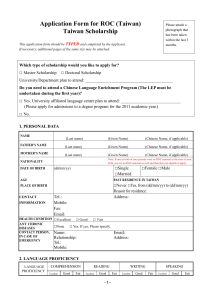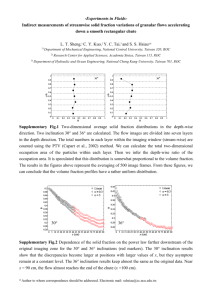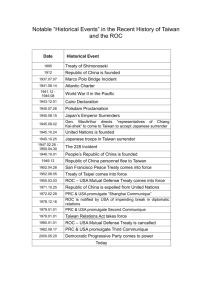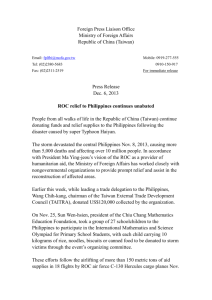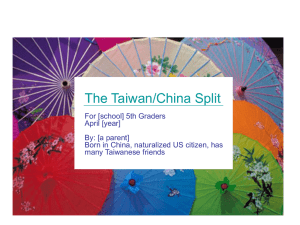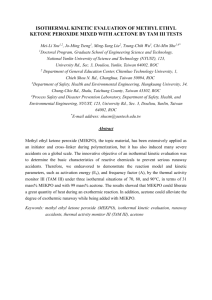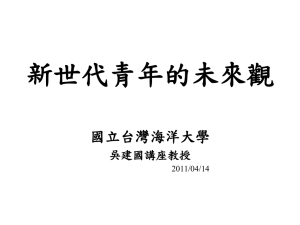Taiwan_BBP - ArtMathOnline
advertisement
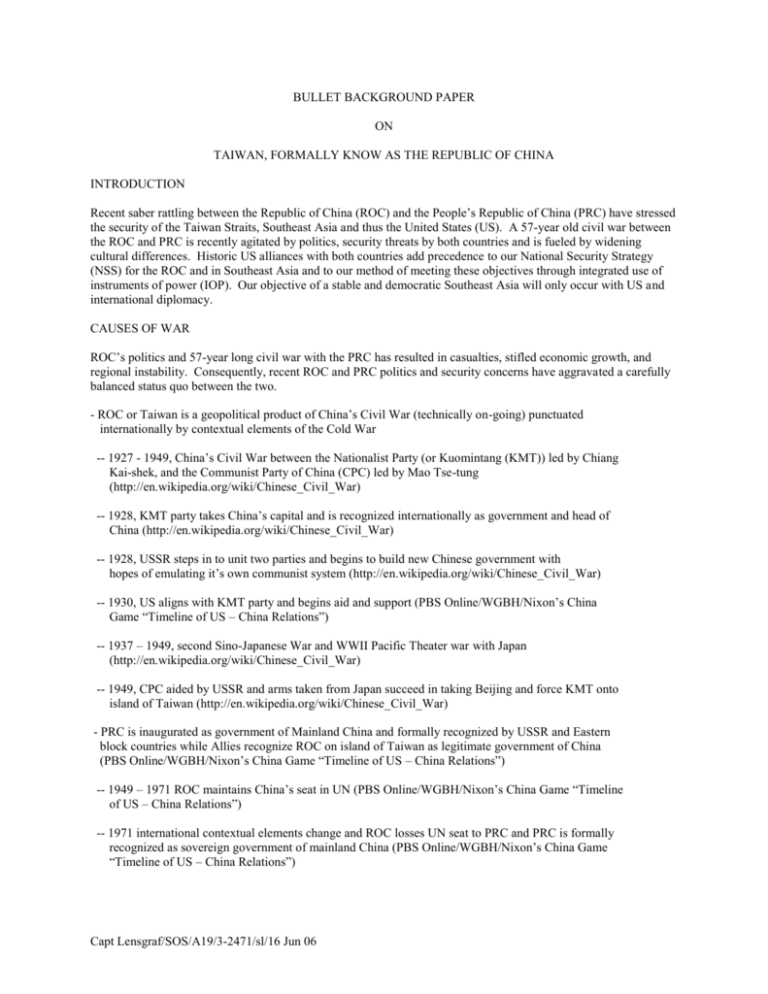
BULLET BACKGROUND PAPER ON TAIWAN, FORMALLY KNOW AS THE REPUBLIC OF CHINA INTRODUCTION Recent saber rattling between the Republic of China (ROC) and the People’s Republic of China (PRC) have stressed the security of the Taiwan Straits, Southeast Asia and thus the United States (US). A 57-year old civil war between the ROC and PRC is recently agitated by politics, security threats by both countries and is fueled by widening cultural differences. Historic US alliances with both countries add precedence to our National Security Strategy (NSS) for the ROC and in Southeast Asia and to our method of meeting these objectives through integrated use of instruments of power (IOP). Our objective of a stable and democratic Southeast Asia will only occur with US and international diplomacy. CAUSES OF WAR ROC’s politics and 57-year long civil war with the PRC has resulted in casualties, stifled economic growth, and regional instability. Consequently, recent ROC and PRC politics and security concerns have aggravated a carefully balanced status quo between the two. - ROC or Taiwan is a geopolitical product of China’s Civil War (technically on-going) punctuated internationally by contextual elements of the Cold War -- 1927 - 1949, China’s Civil War between the Nationalist Party (or Kuomintang (KMT)) led by Chiang Kai-shek, and the Communist Party of China (CPC) led by Mao Tse-tung (http://en.wikipedia.org/wiki/Chinese_Civil_War) -- 1928, KMT party takes China’s capital and is recognized internationally as government and head of China (http://en.wikipedia.org/wiki/Chinese_Civil_War) -- 1928, USSR steps in to unit two parties and begins to build new Chinese government with hopes of emulating it’s own communist system (http://en.wikipedia.org/wiki/Chinese_Civil_War) -- 1930, US aligns with KMT party and begins aid and support (PBS Online/WGBH/Nixon’s China Game “Timeline of US – China Relations”) -- 1937 – 1949, second Sino-Japanese War and WWII Pacific Theater war with Japan (http://en.wikipedia.org/wiki/Chinese_Civil_War) -- 1949, CPC aided by USSR and arms taken from Japan succeed in taking Beijing and force KMT onto island of Taiwan (http://en.wikipedia.org/wiki/Chinese_Civil_War) - PRC is inaugurated as government of Mainland China and formally recognized by USSR and Eastern block countries while Allies recognize ROC on island of Taiwan as legitimate government of China (PBS Online/WGBH/Nixon’s China Game “Timeline of US – China Relations”) -- 1949 – 1971 ROC maintains China’s seat in UN (PBS Online/WGBH/Nixon’s China Game “Timeline of US – China Relations”) -- 1971 international contextual elements change and ROC losses UN seat to PRC and PRC is formally recognized as sovereign government of mainland China (PBS Online/WGBH/Nixon’s China Game “Timeline of US – China Relations”) Capt Lensgraf/SOS/A19/3-2471/sl/16 Jun 06 US INVOLVMENT National Security Strategy goal of spreading democracy, creating free trade and free markets and ensuring human dignity are high ideals the ROC now emulates after 57 years of US aid and democratic growth. Taiwan is attempting to gain official recognition by the international community and in doing so upsetting the status quo between the ROC and PRC. - US maintains steady relationship with ROC aiding in its security -- 1951, US appoints Military Assistance Advisory Group for Taiwan and resumes direct military aid to Taiwan (PBS Online/WGBH/Nixon’s China Game “Timeline of US – China Relations”) -- 1954, US joins 7 other countries in signing a regional defense treaty, Southeast Asia Treaty Organization (SEATO) basically modeled from NATO designed to contain communism--dissolves in 1977 (The Columbia Electronic Encyclopedia, 6th ed. Copyright © 2006, Columbia University Press. http://www.infoplease.com/ce6/history/A0846053.html) -- 1954, US enters into mutual defense treaty with ROC, pledging US support for Taiwan against any attack from mainland China. ROC makes clear in will consult with US before attacking China (PBS Online/WGBH/Nixon’s China Game “Timeline of US – China Relations”) -- 1955, Eisenhower signs Formosa Resolution, threatening US military intervention in Taiwan Strait crisis (PBS Online/WGBH/Nixon’s China Game “Timeline of US – China Relations”) -- 1995-96, US uses Naval presence to safeguard ROC during PRC military buildup along Taiwan Strait - US maintains steady relationship with ROC aiding its economy -- 1965, US Agency for International Development announces end of non-military aid to ROC. Military aid will continue (PBS Online/WGBH/Nixon’s China Game “Timeline of US – China Relations”) -- 1951-1964, $100M in US aid and based on earlier industrial build-up, Taiwanese economy now took off and became fastest growing national economy in the world for two decades (“The Taiwan Economic Miracle” (Lauri Paltemaa), The Center for East Asian Studies, University of Turku, 15 Feb 2006) -- ROC and PRC gain entry to World Trade Organization (WTO) with US endorsement - US maintains steady political aid to ROC -- 1971, UN votes to admit PRC and expel ROC after 22 years of successful US intervention -- 1979, US signs Taiwan Relations Act, which legalizes new US relationship with Taiwan. Under bill, US continues to treat TAIWAN as independent nation, sell it arms, lend it money, recognize its passports and grant its diplomats immunity from US law (www.taiwandocuments.org, Taiwan Relations Act, Publilc Law 96-8) -- US publicly supports International recognition of Taiwan but is currently unwilling to back UN resolution to formally recognize Taiwan -- ROC’s current “…economic prosperity is the envy of Asia.” (“Relations across the Taiwan Strait”, by June Teufel Dreyer, Special to CNN Interactive, cnn.com”) Capt Lensgraf/SOS/A19/3-2471/sl/16 Jun 06 FORECAST AND RECOMMENDATIONS ROC security and international status will be secured in the short term by US military aid and arms sales but in the long term the ROC will receive its sovereignty status and be released from the threat of invasion from the PRC. - 2000, Chen Shui-bian of Democratic Progressive Party (DPP) wins ROC Presidential race and within first year publishes “White Paper on China Policy for 21 st Century” which outlines four pillars for Taiwan security (“White Paper on China Policy for 21 st Century”, www.taiwandocuments.org, 30 Nov 1999) -- Clear national status -- Normalization of across-strait relations -- Strong national defense force -- Stable economic development -- PRC reacts heatedly over DPP party’s departure from 57-year status quo and quickly enacts “Anti Assession Law” (“China Eases It’s Stance on Taiwan”, Edward Cody, Washington Post Foreign Service, 15 Jun 2006) -- 2006, Re-elected ROC President Chen Shei-bian backs off Taiwan Independence issue (Taiwan From Wikipedia, the free encyclopedia) -- 2006, China substantially softens stand on Taiwan, ROC and PRC resume half-century old status quo (Taiwan From Wikipedia, the free encyclopedia) - US and international community must continue to use diplomatic and military means of protecting ROC’s limited independent status from PRC until two governments can negotiate a peace -- US must continue to sell arms to ROC for their continued self defense “Bush Defends Taiwan Arms Sales”, BBC News online, 25 Apr 2001) -- Countries must continue pressuring UN and PRC on ROC independence and sovereign nation status (“Official Proposal for the UN General Assembly to examine the exceptional international situation pertaining to the Republic of China on Taiwan”, www.Taiwandocuments.org) - Time, ROC’s strong global economy, and China’s own globally tied economic growth will eventually overshadow the history separating ROC from true independence SUMMARY The Republic of China’s (on Taiwan) 57-year old civil war with the People’s Republic of China (on Mainland China) is rooted in the Cold War and sustained by the international players of that war including the US. In the last 30 years the ROC achieved remarkable and envied success both domestically through democratic and economic reform and internationally as a world economic power and global contributor (WTO, World Bank), for which the US has also contributed. Preservation of the ideals for which Taiwan now stands as well as continued Southeast Asian security remains in the hands of the US and the International community. Capt Lensgraf/SOS/A19/3-2471/sl/16 Jun 06
